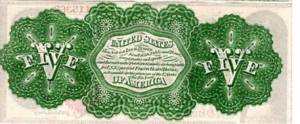
I am not an economist, and I don’t play one on TV, but you don’t have to be an economist to understand the basics of money.
We often forget that money has no fixed, real value. You can’t eat it. You can’t drive it, or live in it. Money is only valuable as a tool to trade for goods and services. You never really want the money. You want what it buys.
We know this, though we seldom think about it. There are lots of stories about people stranded on desert islands, or in science fiction, where the “rich guy” offers tries to buy food with his handy pile of cash. The point of the story is that money is sometimes useless.
What we forget is that money is always useless. It is a substitute — a proxy for what you buy with it. If I am a farmer, and I raise wheat, I sell the wheat for dollars. When I take those dollars and put them in the bank, in a sense I put the grain in the bank. When I withdraw the dollars and buy a melon, I am trading the grain that the dollars represent for the melon.
If I sell a lot of wheat, and put all the money in the bank, I have exchanged my wheat for dollars that I trust will be valuable in the future to buy things. My savings of dollars represents the surplus of grain that I have produced, and not consumed. I have traded my grain for dollars, which I trust that I can trade for something I want in the future.
In the same way our IRA or 401K represents our excess production over our lifetimes. We have sold our labor, our skills and our products to get dollars. Our savings of dollars represent all that productivity, and the promise that we will be able to exchange those dollars for things that we want in retirement.
Money is the yardstick that allows us to divide up things of value. I don’t have to trade my whole cow for something. I can sell the cow for dollars, and buy several things with the dollars. I can also store the value. I don’t have to trade the cow today. I can trade the cow for dollars, and save the dollars for the future, when I go to buy what I want.
With dollars, we can immediately and accurately measure the value of things and trade with precision.
People used to talk about money being “backed” by something – meaning that it could be “redeemed” at any time for something with intrinsic, reliable value, like gold or silver. Up until the 1930s, the US Dollar was on the “gold standard”, meaning that you could always go to the bank and get gold at a fixed exchange rate for your dollars. ($20.67 per ounce) Today’s money is what economists call “fiat” currency, backed only by the faith we have in its value. We have worked with money for so long, and so effectively, that we forget this. We measure our economy in dollars, and plan our retirements in dollars, and gauge our success in dollars. Our faith is effortless and complete.
Such faith assumes that a dollar tomorrow will be worth roughly the same as it is today.
Unfortunately, the history of money is punctuated with periods of inflation and deflation, poor money management by central banks, and other disasters. Germany in the 1920s, Zimbabwe in the last decade, and many other places have experienced the total collapse of the local currency. Even in modern US history, we have seen annual inflation of almost 15%, less than 35 years ago. The dollar is one of the most stable and reliable currencies in the world, but the track record of government money managers throughout history should give us pause.
Dollars are a yardstick and value storage tool. They have no real value themselves except as a way of precisely measuring and storing the value of things we trade for them.
Our debts are also measured in dollars. What happens when a huge debtor has the ability to tamper with the length of our yardstick?
The answer in part 2.

